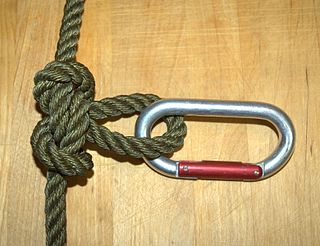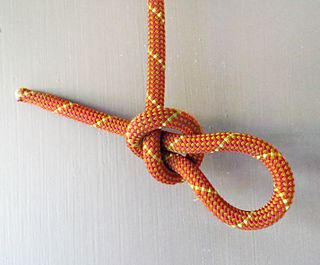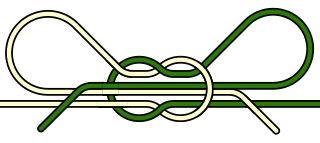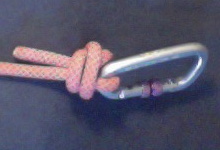
A knot is an intentional complication in cordage which may be practical or decorative, or both. Practical knots are classified by function, including hitches, bends, loop knots, and splices: a hitch fastens a rope to another object; a bend fastens two ends of a rope to each another; a loop knot is any knot creating a loop, and splice denotes any multi-strand knot, including bends and loops. A knot may also refer, in the strictest sense, to a stopper or knob at the end of a rope to keep that end from slipping through a grommet or eye. Knots have excited interest since ancient times for their practical uses, as well as their topological intricacy, studied in the area of mathematics known as knot theory.

The overhand knot, also known as a a knot and half knot, is one of the most fundamental knots, and it forms the basis of many others, including the simple noose, overhand loop, angler's loop, reef knot, fisherman's knot, and water knot. The overhand knot is a stopper, especially when used alone, and hence it is very secure, to the point of jamming badly. It should be used if the knot is intended to be permanent. It is often used to prevent the end of a rope from unraveling. An overhand knot becomes a trefoil knot, a true knot in the mathematical sense, by joining the ends.

The granny knot is a binding knot, used to secure a rope or line around an object. It is considered inferior to the reef knot, which it superficially resembles. Neither of these knots should be used as a bend knot for attaching two ropes together.
The granny knot is also called the false, lubber's, calf, and booby knot. Patterson's Nautical Encyclopedia calls it "old granny knot" and Sir Edwin Arnold calls it the "common or garden knot." The name granny is given in Vocabulary of Sea Phrases and Roding pictures the knot in 1795.
The granny consists of two identical half knots, one tied on top of the other. It has but one practical purpose that I know of and that is to serve as a surgeon's knot. Formerly it was employed for tying up parcels in five-and-ten-cent stores, but the practice was given up and paper bags substituted as they were found to be simpler.

The butterfly loop, also known as lineman's loop, butterfly knot, alpine butterfly knot and lineman's rider, is a knot used to form a fixed loop in the middle of a rope. Tied in the bight, it can be made in a rope without access to either of the ends; this is a distinct advantage when working with long climbing ropes. The butterfly loop is an excellent mid-line rigging knot; it handles multi-directional loading well and has a symmetrical shape that makes it easy to inspect. In a climbing context it is also useful for traverse lines, some anchors, shortening rope slings, and for isolating damaged sections of rope.

The constrictor knot is one of the most effective binding knots. Simple and secure, it is a harsh knot that can be difficult or impossible to untie once tightened. It is made similarly to a clove hitch but with one end passed under the other, forming an overhand knot under a riding turn. The double constrictor knot is an even more robust variation that features two riding turns.

Figure-eight loop is a type of knot created by a loop on the bight. It is used in climbing and caving where rope strains are light to moderate and for decorative purposes.
The Flemish loop or figure-eight loop is perhaps stronger than the loop knot. Neither of these knots is used at sea, as they are hard to untie. In hooking a tackle to any of the loops, if the loop is long enough it is better to arrange the rope as a cat's paw.

A Zeppelin bend is an end-to-end joining knot formed by two symmetrically interlinked overhand knots. It is stable, secure, and highly resistant to jamming. It is also resistant to the effects of slack shaking and cyclic loading.

A double bowline is a type of loop knot. Instead of the single turn of the regular bowline, the double bowline uses a round turn. This forms a more secure loop than a standard bowline.

The slip knot is a stopper knot which is easily undone by pulling the tail. The slip knot is related to the running knot, which will release when the standing end is pulled. Both knots are identical and are composed of a slipped overhand knot, where a bight allows the knot to be released by pulling on an end; the working end for a slip knot, and the standing end for a running knot. The slip knot is used as a starting point for crochet and knitting.
The slip knot is a stopper knot that may be spilled or slipped instantly by pulling on the end to withdraw a loop. There is but one knot entitled to the name; any others having a similar feature are merely " slipped" knots.

A Matthew Walker knot is a decorative knot that is used to keep the end of a rope from fraying. It is tied by unraveling the strands of a twisted rope, knotting the strands together, then laying up the strands together again. It may also be tied using several separate cords, in which case it keeps the cords together in a bundle. The traditional use of the knot is to form a knob or "stopper" to prevent the end of the rope from passing through a hole, for instance in rigging the lanyards which tension the shrouds on older sailing ships with standing rigging of fibre cordage.

The surgeon's knot is a surgical knot and is a simple modification to the reef knot. It adds an extra twist when tying the first throw, forming a double overhand knot. The additional turn provides more friction and can reduce loosening while the second half of the knot is tied. This knot is commonly used by surgeons in situations where it is important to maintain tension on a suture, giving it its name.

The sailmaker's whipping is one of the most durable and stable of rope whippings known. According to The Ashley Book of Knots, "palm-and-needle whipping, or sailmaker's whipping, is the most satisfactory of all."

The double overhand knot is simply an extension of the regular overhand knot, made with one additional pass. The result is slightly larger and more difficult to untie. It forms the first part of the surgeon's knot and both sides of a double fisherman's knot. The strangle knot is a rearranged double overhand knot made around an object. It is sometimes used to secure items to posts. According to The Ashley Book of Knots, "A double overhand knot tied in a cat-o'-nine-tails is termed a blood knot."

The strangle knot is a simple binding knot. Similar to the constrictor knot, it also features an overhand knot under a riding turn. A visible difference is that the ends emerge at the outside edges, rather than between the turns as for a constrictor. This knot is a rearranged double overhand knot and makes up each half of the double fisherman's knot.
The strangle knot starts with a round turn and the end is stuck under two parts. It may be used to tie up a roll.It can only be tied around a cylindrical shape. If required, a loop may be stuck instead of the end, which makes a slipped knot that is one of the best for tying up sacks and meal bags. With one or two additional turns the strangle knot makes an excellent temporary whipping for the end of a rope.

The fiador knot is a decorative, symmetrical knot used in equine applications to create items such as rope halters, hobbles, and components of the fiador on some hackamore designs. As traditionally described, it is a four strand diamond knot in which six of the eight ends loop back into the knot, thus allowing it to be tied with a single line. While a specific knot is discussed in this article, the fiador knot has also been treated as an entire class of multi-strand knots similarly made with a single line.

The shoelace knot, or bow knot, is commonly used for tying shoelaces and bow ties.

The double overhand noose is a very secure hitch knot. It might be used by cavers and canyoneers to bind a cow tail or a foot loop to a carabiner.[ [File:Noeud double gansé.jpg|thumb|Double overhand noose binding carabiners.]]

The reef knot, or square knot, is an ancient and simple binding knot used to secure a rope or line around an object. It is sometimes also referred to as a Hercules knot. The knot is formed by tying a left-handed overhand knot and then a right-handed overhand knot, or vice versa. A common mnemonic for this procedure is "right over left; left over right", which is often appended with the rhyming suffix "... makes a knot both tidy and tight". Two consecutive overhands of the same handedness will make a granny knot. The working ends of the reef knot must emerge both at the top or both at the bottom, otherwise a thief knot results.
The reef knot or square knot consists of two half knots, one left and one right, one being tied on top of the other, and either being tied first...The reef knot is unique in that it may be tied and tightened with both ends. It is universally used for parcels, rolls and bundles. At sea it is always employed in reefing and furling sails and stopping clothes for drying. But under no circumstances should it ever be tied as a bend, for if tied with two ends of unequal size, or if one end is stiffer or smoother than the other, the knot is almost bound to spill. Except for its true purpose of binding it is a knot to be shunned.

The Chinese button knot is essentially a knife lanyard knot where the lanyard loop is shortened to a minimum, i.e. tightened to the knot itself. There emerges therefore only two lines next to each other from the knot: the beginning and the end. The knot has traditionally been used as a button on clothes in Asia, thus the name.
The Chinese Button Knot is worn throughout China on underwear and night clothes. Buttons of this sort are more comfortable to lie on and to rest against compared to common bone and composition buttons, and they cannot be broken even by the laundry.
A Chinese tailor ties the knot without guide, flat on his table. But one may be more quickly and easily tied in hand by a modification of the sailor’s method of tying his knife lanyard knot (#787). The two knots are tied alike, but they are worked differently.




















